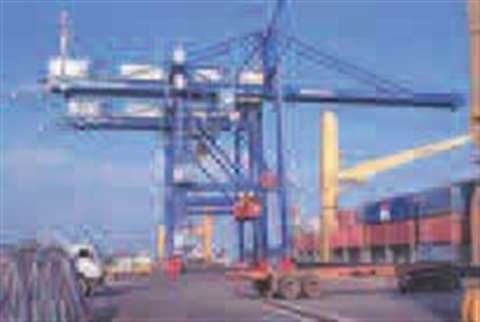Mobile feeder system to reduce cost
08 May 2008

The maritime cargo industry is constantly striving for quick and cost effective load handling and favours ports that offer the most favourable conditions. According to Kranbau Eberswalde, ports can achieve profitable container handling with feeder vessels up to Panamax class when using the company's new mobile feeder server.
The self-powered RTG has been specially designed for quick and profitable container handling of smaller vessels.
Feeder ships are vessels that distribute loads from a larger container terminal to further smaller regional ports. They are generally one or two classes smaller than the main vessels and cover shorter distances. Typical feeder vessels are Panamax class and smaller.
According to Kranbau Eberswalde, stevedoring companies around the world have said that their container handling with feeder vessels is very slow using existing post-Panamax cranes or traditioal mobile harbour cranes. Long distances to berthing areas for feeder vessels lead to further costs.
The main disadvantages, says Kranenbau Eberswalde, of today's feeder ship servicing with post Panamax or mobile harbour cranes, are low container throughput rates, long distances for internal container transport, ships staying longer at the berthing area and the time-consuming engagement of personnel and equipment.
As mentioned before, different types of cranes are used for container handling with small- and medium-sized feeder vessels, and Kranenbau Eberswalde says analysis of their operational characteristics shows, as well as crane related costs per TEU (twenty foot equivalent unit), a big difference compared with the mobile feeder. These can roughly be calculated as shown in Table 1, which looks at the expected lifetime of a crane, its price and the operated container handling volume, related to a certain period. Using a 12-month period as an example, the crane handling costs per TEU result from the following equation:
Where US$ (estimated crane price)
Years (expected crane life)
TEU (containers handled in one year)
The comparison of costs for handling 1000 TEU (right-hand column of the table) shows that the best results in container handling will be achieved when: either post-Panamax gantry cranes are used for servicing adequately large vessels, or mobile gantry cranes are used for servicing small- and medium-sized feeder vessels.
According to Table 1, the crane-related costs for handling 1000 TEU are about US$ 1.70 for these two types of crane, which is the normal value for well suited craneage in ports and container terminals. Table 1 also shows that:
1. The costs for handling 1000 TEU will rise to approx. US$ 2.86 when using post-Panamax gantry cranes for handling containers with small feeder vessels.
2. The costs for handling 1000 TEU will rise to approx. US$ 4.46 when working with traditional mobile harbour cranes.
A further disadvantage, Kranbau Eberswalde claims, derives from the poor container throughput and long loading times of traditional mobile harbour cranes, resulting in vessels staying at the port up to twice as long as where a mobile feeder server is used.




